AACR2 Part I - Joint Steering Committee for Development of RDA
AACR2 Part I - Joint Steering Committee for Development of RDA
AACR2 Part I - Joint Steering Committee for Development of RDA
You also want an ePaper? Increase the reach of your titles
YUMPU automatically turns print PDFs into web optimized ePapers that Google loves.
5JSC/Sec/7<br />
16 November 2008<br />
1<br />
To:<br />
From:<br />
Subject:<br />
<strong>Joint</strong> <strong>Steering</strong> <strong>Committee</strong> <strong>for</strong> <strong>Development</strong> <strong>of</strong> <strong>RDA</strong><br />
Nathalie Schulz, Secretary, JSC<br />
Changes to <strong>AACR2</strong> Instructions<br />
This document lists changes made to <strong>AACR2</strong> instructions during the development <strong>of</strong><br />
<strong>RDA</strong> to date. It is not a complete list, and consists primarily <strong>of</strong> changes that have been<br />
noted at JSC meetings and in JSC correspondence. Please send any additional changes<br />
identified during review <strong>of</strong> the full draft <strong>of</strong> <strong>RDA</strong> to the JSC Secretary.<br />
This document does not cover new elements in <strong>RDA</strong> compared to <strong>AACR2</strong> (e.g.,<br />
Production statement; Uni<strong>for</strong>m Resource Locator), or <strong>AACR2</strong> instructions that have been<br />
generalized to cover a wider range <strong>of</strong> resources.<br />
<strong>AACR2</strong> <strong>Part</strong> I<br />
X.0 General Rules<br />
• The following changes have been made to <strong>AACR2</strong> 1.0C1 at the request <strong>of</strong> the<br />
ISBD Review Group (<strong>RDA</strong> D.2.2.1, see 5JSC/<strong>RDA</strong>/Full draft/Addenda/Appendix<br />
D):<br />
o Each adjacent data element that requires square brackets is enclosed in its<br />
own set <strong>of</strong> square brackets.<br />
o When an element or area ends with a full stop, the full stop <strong>for</strong> prescribed<br />
punctuation is also added.<br />
• The counterpart to the levels <strong>of</strong> description in <strong>AACR2</strong> rule 1.0D is the list <strong>of</strong> core<br />
elements at <strong>RDA</strong> 0.6.<br />
• <strong>AACR2</strong> 1.0E lists a number <strong>of</strong> elements which are to be transcribed in the<br />
language and script as found on the item. <strong>RDA</strong> 1.4 lists equivalent elements, but<br />
provides an optional addition to record them in a transliterated <strong>for</strong>m in addition to<br />
the <strong>for</strong>m recorded in the script used on the source.<br />
• <strong>AACR2</strong> 1.0F1 specifies that an inaccuracy is to be transcribed followed by “[sic]”,<br />
or “i.e.” and a correction in square brackets. In <strong>RDA</strong>, inaccuracies are transcribed<br />
as found on the source. If necessary, a note may be made correcting the<br />
inaccuracy. There is an exception <strong>for</strong> the title proper <strong>of</strong> serials and integrating<br />
resources to correct the error (<strong>RDA</strong> 2.3.1.4).<br />
X.1B Title proper<br />
• <strong>AACR2</strong> 1.1B1 specifies the replacement <strong>of</strong> certain marks <strong>of</strong> punctuation in titles<br />
proper. In <strong>RDA</strong> punctuation will be transcribed as it appears.<br />
• <strong>AACR2</strong> 1.1B1 specifies punctuation and capitalization <strong>for</strong> alternative titles. In<br />
<strong>RDA</strong> the general instruction to add punctuation as required <strong>for</strong> clarity will apply.
5JSC/Sec/7<br />
16 November 2008<br />
2<br />
• In cases where there is both a collective title and the titles <strong>of</strong> individual works,<br />
<strong>AACR2</strong> 1.1B10 specifies that the titles <strong>of</strong> the individual works should be given in<br />
a contents note. In <strong>RDA</strong> there is an optional addition to record the titles <strong>of</strong> the<br />
individual contents as titles <strong>of</strong> related works (<strong>RDA</strong> 2.3.2.6).<br />
• <strong>AACR2</strong> 12.1B3 specifies when to consider that the name <strong>of</strong> a corporate body is<br />
part <strong>of</strong> the title <strong>for</strong> continuing resources. This instruction is not present in <strong>RDA</strong> as<br />
it is no longer necessary in the context <strong>of</strong> the major/minor title change conditions<br />
(it should have been deleted as part <strong>of</strong> the <strong>AACR2</strong> 2002 revisions).<br />
• <strong>AACR2</strong> 12.1B7 says not to include the mark <strong>of</strong> omission when omitting<br />
in<strong>for</strong>mation that varies from issue to issue that occurs at the beginning <strong>of</strong> the title.<br />
<strong>RDA</strong> 2.3.1.4 does not include this filing convention, which in MARC 21<br />
encoding can be handled by indicators.<br />
X.1C General material designation<br />
• The General Material Designation has been replaced by <strong>RDA</strong> Media type (3.2),<br />
Carrier Type (3.3), and Content type (6.10).<br />
X.1D Parallel titles<br />
• <strong>AACR2</strong> 1.1D1 says that parallel titles are to be transcribed in the order found on<br />
the chief source <strong>of</strong> in<strong>for</strong>mation. According to <strong>RDA</strong> 2.3.3.2 parallel titles may be<br />
taken from any source within the resource.<br />
• <strong>AACR2</strong> 1.1D2 is not present in <strong>RDA</strong>. This rule specified which parallel titles to<br />
record when preparing a second-level description. In <strong>RDA</strong>, there are no<br />
limitations.<br />
X.1E Other title in<strong>for</strong>mation<br />
• <strong>AACR2</strong> 1.1E6 on supplying other title in<strong>for</strong>mation is not present in <strong>RDA</strong>. This<br />
goes against the principle <strong>of</strong> representation. However, other title in<strong>for</strong>mation may<br />
be supplied <strong>for</strong> cartographic resources (<strong>RDA</strong> 2.3.4.5) and moving image<br />
resources (<strong>RDA</strong> 2.3.4.6 ).<br />
• <strong>AACR2</strong> 12.1E1 specifies that other title in<strong>for</strong>mation is only to be recorded <strong>for</strong><br />
continuing resources if considered to be important. <strong>RDA</strong> does not have this<br />
limitation, although it should be noted that “other title in<strong>for</strong>mation” is not a core<br />
element.<br />
X.1F Statement <strong>of</strong> responsibility<br />
• <strong>AACR2</strong> 1.1A2 says that a statement <strong>of</strong> responsibility which is not on the chief<br />
source <strong>of</strong> in<strong>for</strong>mation should be recorded in square brackets. In <strong>RDA</strong>, the only<br />
statements <strong>of</strong> responsibility that will appear in square brackets are those taken<br />
from outside the resource (<strong>RDA</strong> 2.2.4).
5JSC/Sec/7<br />
16 November 2008<br />
3<br />
• <strong>AACR2</strong> 1.1F5 limits the number <strong>of</strong> people or corporate bodies which can be<br />
recorded in a single statement <strong>of</strong> responsibility. <strong>RDA</strong> does not have this artificial<br />
limitation. However, there is an optional omission (2.4.1.5) to allow the first<br />
person or body to be named and the omission summarized.<br />
• <strong>AACR2</strong> 1.1F7 lists categories <strong>of</strong> in<strong>for</strong>mation not to be transcribed in statements<br />
<strong>of</strong> responsibility. <strong>RDA</strong> 2.4.1.4 says to transcribe as found, with an option to omit<br />
in<strong>for</strong>mation.<br />
• <strong>AACR2</strong> 1.1F12 details the conditions in which a noun phrase occurring in<br />
conjunction with a statement <strong>of</strong> responsibility is considered part <strong>of</strong> the statement<br />
<strong>of</strong> responsibility and when it is other title in<strong>for</strong>mation. According to <strong>RDA</strong> 2.4.1.8<br />
these phrases are always considered part <strong>of</strong> the statement or responsibility.<br />
• <strong>AACR2</strong> 1.1F13 is not present in <strong>RDA</strong>. It is not necessary as statements <strong>of</strong><br />
responsibility will be recorded as found.<br />
• <strong>AACR2</strong> 12.1F3 limits the cases in which statements <strong>of</strong> responsibility are recorded<br />
<strong>for</strong> editors. <strong>RDA</strong> does not have this limitation. (Note: this decision was made at<br />
the October 2007 meeting (5JSC/M/198.10.3) and at that time the statement <strong>of</strong><br />
responsibility was an optional element.)<br />
X.1G Items without a collective title<br />
• The following change has been made to <strong>AACR2</strong> 1.1G3 at the request <strong>of</strong> the ISBD<br />
Review Group (<strong>RDA</strong> D.2.2.2, see 5JSC/<strong>RDA</strong>/Full draft/Addenda/Appendix D):<br />
o The groups <strong>of</strong> data will still be separated by a full stop, but this will now<br />
be followed by one space instead <strong>of</strong> two.<br />
X.2B Edition statement<br />
• <strong>AACR2</strong> 1.2B1 specifies use <strong>of</strong> abbreviations found in Appendix B. In <strong>RDA</strong> there<br />
is no abbreviation in this element unless found in the sources <strong>of</strong> in<strong>for</strong>mation <strong>for</strong><br />
the element.<br />
• <strong>AACR2</strong> C.2B1 says to substitute arabic numerals <strong>for</strong> roman in the edition<br />
statement. <strong>AACR2</strong> C.3B1 says to substitute arabic numerals <strong>for</strong> numbers<br />
expressed as words in the edition statement. In <strong>RDA</strong> no substitutions will be made<br />
as the edition statement is not listed at <strong>RDA</strong> 1.8.<br />
3.3 Mathematical and other material specific details<br />
• <strong>AACR2</strong> 3.3B specifies some cases where scale in<strong>for</strong>mation is recorded in square<br />
brackets. <strong>RDA</strong> 7.25 does not have this provision as this in<strong>for</strong>mation can be taken<br />
from any source. The ratio is not preceded by “Scale”.<br />
• <strong>AACR2</strong> 3.3C says that when giving the statement <strong>of</strong> projection to use<br />
abbreviations as instructed in appendix B. <strong>RDA</strong> 7.26 does not refer to the<br />
appendix on abbreviations.
5JSC/Sec/7<br />
16 November 2008<br />
4<br />
• <strong>AACR2</strong> 3.3D2 specifies abbreviations used in recording right ascension and<br />
declination. <strong>RDA</strong> 7.4.4 says to use “Right ascension” and “Declination”.<br />
• <strong>AACR2</strong> 3.3D2: Because epoch (<strong>RDA</strong> 7.5) and equinox (<strong>RDA</strong> 7.6) are separate<br />
elements, they are not preceded by either words or abbreviations.<br />
5.3 Musical presentation statement<br />
• <strong>AACR2</strong> 5.3 covers the transcription <strong>of</strong> musical presentation statements. In <strong>RDA</strong><br />
these will be recorded as a designation <strong>of</strong> edition (<strong>RDA</strong> 2.5.2). This will remove<br />
the existing inconsistency as to where similar in<strong>for</strong>mation is transcribed. This<br />
change also allows <strong>for</strong> the recording <strong>of</strong> statements <strong>of</strong> responsibility associated<br />
with a musical presentation statement as statements <strong>of</strong> responsibility relating to<br />
the edition. <strong>RDA</strong> 7.20 (Format <strong>of</strong> notated music) provides a controlled list <strong>of</strong><br />
terms <strong>for</strong> musical presentation.<br />
12.3 Numbering<br />
• <strong>AACR2</strong> 12.3B1 and 12.3C1 specify use <strong>of</strong> abbreviations found in Appendix B.<br />
According to <strong>RDA</strong>, words used in numbering will be transcribed as they appear.<br />
• <strong>AACR2</strong> 12.3B1 and C.2B1 say to substitute arabic numerals <strong>for</strong> roman in the<br />
numbering area. <strong>RDA</strong> 1.8.2 instructs to record numerals in the <strong>for</strong>m preferred by<br />
the agency creating the data, with alternatives to record numerals in the <strong>for</strong>m in<br />
which they appear on the source <strong>of</strong> in<strong>for</strong>mation, or to record them both ways.<br />
X.4C Place <strong>of</strong> publication, distribution, etc.<br />
• <strong>AACR2</strong> 1.4B4 specifies use <strong>of</strong> abbreviations found in Appendix B. In <strong>RDA</strong> there<br />
will be no abbreviations unless found in the sources <strong>of</strong> in<strong>for</strong>mation.<br />
• <strong>AACR2</strong> 1.4B6, 1.4C2, 1.4C3, 1.4C4 all specify the addition <strong>of</strong> in<strong>for</strong>mation in<br />
square brackets. In <strong>RDA</strong> the element is transcribed as it appears, and notes used to<br />
record additional/different in<strong>for</strong>mation (<strong>RDA</strong> 2.20.6-9).<br />
• <strong>AACR2</strong> 1.4C5 specifies what to do when there is more than one place listed.<br />
<strong>RDA</strong> instructs to record the place names in the order indicated by the sequence,<br />
layout, or typography <strong>of</strong> the names on the source <strong>of</strong> in<strong>for</strong>mation (<strong>RDA</strong> 2.7.2.4,<br />
2.8.2.4, 2.9.2.4, 2.10.2.4).<br />
• <strong>AACR2</strong> 1.4C6 says to use the Latin abbreviation s.l. when no probable place can<br />
be given. <strong>RDA</strong> instructs to use: place <strong>of</strong> publication not identified (and equivalent<br />
<strong>for</strong> other elements) (<strong>RDA</strong> 2.7.2.6, 2.8.2.6, 2.9.2.6, 2.10.2.6).<br />
X.4D Name <strong>of</strong> publisher, distributor, etc.<br />
• <strong>AACR2</strong> 1.4B4 specifies use <strong>of</strong> abbreviations found in Appendix B. In <strong>RDA</strong> there<br />
will be no abbreviations unless found in the sources <strong>of</strong> in<strong>for</strong>mation.
5JSC/Sec/7<br />
16 November 2008<br />
5<br />
• <strong>AACR2</strong> 1.4D2 says to record the name in the shortest <strong>for</strong>m. <strong>RDA</strong> does not have<br />
this limitation.<br />
• <strong>AACR2</strong> 1.4D4 specifies what to do when there is more than one publisher,<br />
distributor, etc. listed. <strong>RDA</strong> instructs to record the names in the order indicated by<br />
the sequence, layout, or typography <strong>of</strong> the names on the source <strong>of</strong> in<strong>for</strong>mation<br />
(<strong>RDA</strong> 2.7.4.5, 2.8.4.5, 2.9.4.5, 2.10.4.5).<br />
• <strong>AACR2</strong> 1.4D6 says to use the Latin abbreviation s.n. when no probable place can<br />
be given. <strong>RDA</strong> instructs to use: publisher not identified (and equivalent <strong>for</strong> other<br />
elements) (<strong>RDA</strong> 2.7.4.7, 2.8.4.7, 2.9.4.7, 2.10.4.7).<br />
X.4F Date <strong>of</strong> publication, distribution, etc.<br />
• <strong>AACR2</strong> 1.4F7 provides a <strong>for</strong>mat <strong>for</strong> supplied dates. At <strong>RDA</strong> 1.9 a different<br />
<strong>for</strong>mat is specified.<br />
• Approximate dates (<strong>for</strong>merly indicated using “ca.”) will be indicated in the same<br />
way as probable dates, using a question mark.<br />
• <strong>AACR2</strong> C.2B1 says to substitute arabic numerals <strong>for</strong> roman in the date <strong>of</strong><br />
publication, distribution, etc., element. <strong>RDA</strong> 1.8.2 instructs to record numerals in<br />
the <strong>for</strong>m preferred by the agency creating the data, with alternatives to record<br />
numerals in the <strong>for</strong>m in which they appear on the source <strong>of</strong> in<strong>for</strong>mation, or to<br />
record them both ways.<br />
X.5 Physical description<br />
• In <strong>AACR2</strong>, metric units are considered abbreviations and followed by a full stop<br />
(e.g., cm.). In <strong>RDA</strong> they are considered to be symbols and are not followed by a<br />
full-stop. For background in<strong>for</strong>mation, see the ALA <strong>Committee</strong> on Cataloging:<br />
Description and Access document: Use <strong>of</strong> full stops with metric unit symbols in<br />
<strong>AACR2</strong>.<br />
• <strong>AACR2</strong> Appendix B contains a number <strong>of</strong> abbreviations that are used in<br />
recording the physical description, e.g., “p.” <strong>for</strong> “pages” and “v.” <strong>for</strong> “volumes”,<br />
“ill.” <strong>for</strong> “illustrations”. In <strong>RDA</strong>, the only abbreviations that will be used in<br />
describing carriers or content are in dimensions, e.g., “in.” <strong>for</strong> “inch”, and<br />
duration, e.g., “hr.” <strong>for</strong> “hour”.<br />
2.5 Physical description <strong>of</strong> books, pamphlets, and printed sheets<br />
• <strong>AACR2</strong> 2.5B3 says to record an estimated number <strong>of</strong> unnumbered pages<br />
preceded by “ca.” or to enclose the exact number in square brackets. In <strong>RDA</strong>, the<br />
word approximately will be used or it will be stated explicitly that the pages are<br />
unnumbered, e.g., 44 unnumbered pages (<strong>RDA</strong> 3.4.5.3).<br />
• <strong>AACR2</strong> 2.5B4 says to correct misleading numbering by using “i.e.”, <strong>RDA</strong><br />
specifies use <strong>of</strong> “that is” (<strong>RDA</strong> 3.4.5.5).
5JSC/Sec/7<br />
16 November 2008<br />
6<br />
• <strong>AACR2</strong> 2.5B7 requires the cataloguer to count or estimate the number <strong>of</strong> pages or<br />
leaves when these are unnumbered. <strong>RDA</strong> 3.4.5.3 makes it possible to record “1<br />
volume (unpaged)”.<br />
• <strong>AACR2</strong> 2.5B15 said to use “+ p.” to indicate missing pages. In <strong>RDA</strong><br />
“(incomplete)” will be added instead as it conveys more in<strong>for</strong>mation to catalogue<br />
users (<strong>RDA</strong> 3.4.5.6).<br />
• <strong>AACR2</strong> 2.5B18 specifies how to record the number <strong>of</strong> bibliographic volumes<br />
when this differs to the number <strong>of</strong> physical volumes. In <strong>RDA</strong>, bibliographic<br />
volumes will only be recorded in the extent <strong>for</strong> completed serials (<strong>RDA</strong> 3.4.5.16).<br />
• <strong>AACR2</strong> 2.5D5 says that when separate physical units <strong>of</strong> varying height have been<br />
bound together to give the height <strong>of</strong> the binding only. According to <strong>RDA</strong><br />
3.5.1.4.14, in addition a note may be given if considered important <strong>for</strong><br />
identification or selection. There is also a new exception to record the height or<br />
height × width <strong>of</strong> the text block followed by the height or height × width <strong>of</strong> the<br />
binding if they are different, and it is considered to be important. See the<br />
5JSC/CILIP/2 series <strong>for</strong> background in<strong>for</strong>mation.<br />
2.17 Physical description <strong>of</strong> early printed monographs<br />
• <strong>AACR2</strong> 2.17B1 lists “metal cuts” as a term that can be added after types <strong>of</strong><br />
illustrations. Because <strong>of</strong> misuse <strong>of</strong> this term (which should be restricted almost<br />
entirely to 15th century German books), in <strong>RDA</strong> the production method<br />
“lithograph” will be used instead (<strong>RDA</strong> 3.9.1.3).<br />
5.5 Physical description <strong>of</strong> music<br />
• <strong>AACR2</strong> 5.5B2 specifies the use <strong>of</strong> v. <strong>of</strong> music, p. <strong>of</strong> music, or leaves or music<br />
when one <strong>of</strong> the specific material designations is not appropriate. In <strong>RDA</strong>, the<br />
term “score” has been redefined to allow its use in these situations. See the<br />
5JSC/ALA/4 series <strong>for</strong> background in<strong>for</strong>mation.<br />
1.6G Numbering within series<br />
• <strong>AACR2</strong> 1.6G1 specifies use <strong>of</strong> abbreviations found in Appendix B. <strong>AACR2</strong><br />
B.5B1 says that abbreviations can be substituted. <strong>RDA</strong> does not have this<br />
provision. However, the “Numbering <strong>of</strong> part” element (<strong>RDA</strong> 24.6) does specify<br />
use <strong>of</strong> abbreviations and substitution <strong>of</strong> abbreviations.<br />
• <strong>AACR2</strong> C.2B1 says to substitute arabic numerals <strong>for</strong> roman in series numbering.<br />
<strong>RDA</strong> 1.8.2 instructs to record numerals in the <strong>for</strong>m preferred by the agency<br />
creating the data, with alternatives to record numerals in the <strong>for</strong>m in which they<br />
appear on the source <strong>of</strong> in<strong>for</strong>mation, or to record them both ways.
5JSC/Sec/7<br />
16 November 2008<br />
7<br />
<strong>AACR2</strong> <strong>Part</strong> II<br />
Chapter 21 – Choice <strong>of</strong> Access Points<br />
• <strong>AACR2</strong> 21.2 and 21.3 detail how to handle changes in title proper and changes <strong>of</strong><br />
persons or bodies responsible <strong>for</strong> a new work, and specify when a new description<br />
is made <strong>for</strong> serials. <strong>RDA</strong> 1.6 lists some additional situations where a new<br />
description is needed <strong>for</strong> multipart monographs, serials, and integrating resources:<br />
change in mode <strong>of</strong> issuance; and, change in media type. Re-basing <strong>of</strong> an<br />
integrating resource also requires a new description.<br />
• <strong>AACR2</strong> 21.0D lists some designations <strong>of</strong> function, and there is reference to<br />
designations used in other rules. <strong>RDA</strong> has Appendix I <strong>for</strong> relationship designators<br />
<strong>for</strong> relationships between a resource and persons, families, and corporate bodies<br />
associated with a resource.<br />
• <strong>AACR2</strong> 21.6B and 21.6C make a distinction between when two or three, or four<br />
or more persons or bodies share responsibility (i.e., the rule <strong>of</strong> three). <strong>RDA</strong> does<br />
provide instructions on inclusion <strong>of</strong> the preferred access point representing the<br />
person, family, or corporate body with principal responsibility <strong>for</strong> the work in the<br />
preferred access point <strong>for</strong> the work, but does not place any limitations on what in<br />
AACR would be the added entries (see <strong>RDA</strong> Section 6). In addition, there is an<br />
alternative at <strong>RDA</strong> 6.27.1.3 to include the name <strong>of</strong> more than one collaborator in<br />
the access point representing the collaborative work.<br />
• <strong>AACR2</strong> 21.7B1 limits the number <strong>of</strong> added entries that can be made <strong>for</strong><br />
collections <strong>of</strong> works by different persons or bodies. <strong>RDA</strong> does not have this<br />
limitation.<br />
• According to <strong>AACR2</strong> 21.7C1, when a compilation lacks a collective title, it is<br />
entered under the heading <strong>for</strong> the first work in the compilation. This misrepresents<br />
the compilation. In <strong>RDA</strong> separate access points will be constructed <strong>for</strong> each work<br />
in the compilation (<strong>RDA</strong> 6.27.1.4), with an alternative to construct a preferred<br />
access point <strong>for</strong> the compilation using a devised title.<br />
• <strong>AACR2</strong> 21.35A makes a distinction between treaties, etc. between two or three<br />
governments, and those between four or more governments. In <strong>RDA</strong> the first part<br />
<strong>of</strong> the access point representing the work (the <strong>AACR2</strong> main entry) is the<br />
corporate body named first on resources embodying the treaty, or in reference<br />
sources, or if these are inconsistent, the one named first on the first resource<br />
received (<strong>RDA</strong> 6.29.1.15).<br />
• <strong>AACR2</strong> 21.36C6 and 21.36C7 limit added entries to the “first named party on<br />
each side”. <strong>RDA</strong> 19.3.2 does not have this limitation.<br />
Chapter 22 – Headings <strong>for</strong> Persons<br />
• <strong>AACR2</strong> does not include instructions on spaces after full-stops following initials<br />
in personal names. The existing practice <strong>of</strong> Program <strong>for</strong> Cooperative Cataloging,
5JSC/Sec/7<br />
16 November 2008<br />
8<br />
Name Authority Cooperative Program (NACO) libraries to add a space has been<br />
included at <strong>RDA</strong> 8.5.6.<br />
• This sentence from <strong>AACR2</strong> 22.1D2 is not in <strong>RDA</strong>: “Omit a hyphen that joins one<br />
<strong>of</strong> a person’s <strong>for</strong>enames to the surname.”<br />
• <strong>AACR2</strong> 22.2B includes specific instructions on choosing the name to be used as<br />
the basis <strong>for</strong> the heading <strong>for</strong> persons whose works all appear under one<br />
pseudonym, those who have established separate bibliographic identities,<br />
contemporary authors, and others. The corresponding instructions in <strong>RDA</strong> on<br />
persons with more than one identity have been generalized, and include only one<br />
exception (<strong>RDA</strong> 9.2.2.8).<br />
• The following text from <strong>AACR2</strong> 22.3C2 has not been included in <strong>RDA</strong> because it<br />
is “case law”: “In case <strong>of</strong> doubt as to which <strong>of</strong> two or more languages written in<br />
the Arabic script should be used <strong>for</strong> the romanization, base the choice on the<br />
nationality <strong>of</strong> the person or the language <strong>of</strong> the area <strong>of</strong> residence or activity. If<br />
these criteria do not apply, choose (in this order <strong>of</strong> preference): Urdu, Arabic,<br />
Persian, any other language.” The corresponding <strong>RDA</strong> instruction is at 9.2.2.5.3.<br />
• <strong>AACR2</strong> 22.5C contains detailed instructions on compound surnames. Instructions<br />
specific to certain languages have been replaced by a reference to IFLA Names <strong>of</strong><br />
persons: national usages <strong>for</strong> entry in catalogues (<strong>RDA</strong> 9.2.2.10.2)<br />
• <strong>AACR2</strong> 22.15C instructs that other titles or terms associated with persons whose<br />
names contain a surname are to be recorded only if they are required to<br />
distinguish between two or more persons with the same name and neither dates<br />
nor fuller <strong>for</strong>ms <strong>of</strong> name are available. However, people who use terms such as<br />
“Jr.” identify themselves this way and users may look <strong>for</strong> them with the term<br />
included. In <strong>RDA</strong> terms indicating relationship, such as “Jr.”, are treated as part<br />
<strong>of</strong> the name (<strong>RDA</strong> 9.2.2.9.5)<br />
• A number <strong>of</strong> changes have been made to the way that dates are recorded <strong>for</strong><br />
persons (<strong>AACR2</strong> 22.17):<br />
o The examples at <strong>AACR2</strong> 22.17 include abbreviations <strong>for</strong> months in<br />
English. <strong>RDA</strong> Appendix B does not contain any abbreviations <strong>for</strong> months<br />
and the relevant <strong>RDA</strong> instruction specifies that the month is in the<br />
language and script preferred by the agency creating the data (<strong>RDA</strong><br />
9.3.2.3).<br />
o The <strong>AACR2</strong> rule includes use <strong>of</strong> the abbreviations “cent.”, “ca.”, “b.”,<br />
“d.” and “fl.”. <strong>RDA</strong> Appendix B does not include these abbreviations.<br />
“Century” will be spelt out. Instead <strong>of</strong> “ca.”, “approximately” will be used.<br />
The abbreviations “b.”, “d.” and “fl.” are not necessary if the date is<br />
recorded as <strong>RDA</strong> element sub-types, and could be generated <strong>for</strong> display<br />
based on the encoding <strong>for</strong>mat.<br />
o <strong>AACR2</strong> 22.17 specifies that years <strong>of</strong> activity are not to be used <strong>for</strong> dates<br />
in the twentieth century. <strong>RDA</strong> does not have this limitation on recording<br />
period <strong>of</strong> activity.<br />
• <strong>AACR2</strong> 22.18A lists a number <strong>of</strong> cases where the fuller <strong>for</strong>m <strong>of</strong> the name is not<br />
added to a heading, i.e., “unused <strong>for</strong>enames to headings that contain <strong>for</strong>enames:
5JSC/Sec/7<br />
16 November 2008<br />
9<br />
initials <strong>of</strong> names that are not part <strong>of</strong> the heading; unused parts <strong>of</strong> surnames to<br />
headings that contain surnames.” <strong>RDA</strong> does not contain this limitation.<br />
• <strong>AACR2</strong> 22.19B1 allowed terms <strong>of</strong> address (e.g., “Rev.”, “Sir”), titles <strong>of</strong> position<br />
or <strong>of</strong>fice, initials <strong>of</strong> an academic degrees (e.g., “Ph.D.”), and initials denoting<br />
membership in an organization to be used as distinguishing terms. In <strong>RDA</strong>,<br />
additions to access points representing persons are limited to those given in <strong>RDA</strong><br />
9.19.1.2. A term indicating pr<strong>of</strong>ession or occupation is only added <strong>for</strong> a person<br />
whose name consists <strong>of</strong> a phrase or appellation not conveying the idea <strong>of</strong> a person.<br />
Terms <strong>of</strong> address are not used as additions to names, but may be included as part<br />
<strong>of</strong> the name when the name consists only <strong>of</strong> the surname, is <strong>for</strong> a married woman<br />
identified only by her husband's name and a term <strong>of</strong> address (<strong>RDA</strong> 9.2.2.9.4), or<br />
is part <strong>of</strong> a phrase consisting <strong>of</strong> a <strong>for</strong>ename or <strong>for</strong>enames preceded by a term <strong>of</strong><br />
address (<strong>RDA</strong> 9.2.2.23).<br />
Chapter 24 – Headings <strong>for</strong> Corporate Bodies<br />
• <strong>AACR2</strong> 24.7B4 instructs that if the sessions <strong>of</strong> a conference, etc. were held in<br />
three or more locations, to follow the first named place by “etc.” <strong>RDA</strong> instructs to<br />
list all <strong>of</strong> the locations (11.3.2.3). When included in an access point, multiple<br />
locations will be separated by a semi-colon (<strong>RDA</strong> E.2.2.4).<br />
• In <strong>RDA</strong> there is one instruction <strong>for</strong> conferences, congresses, meetings, exhibitions,<br />
fairs, festivals, etc. (11.2.2.11). This results in the following changes to <strong>AACR2</strong>:<br />
Frequency will be retained in the name <strong>of</strong> a conference, congress, or meeting<br />
(<strong>AACR2</strong> 24.7A1). Year <strong>of</strong> convocation will be omitted from exhibitions, fairs,<br />
and festivals (<strong>AACR2</strong> 24.8A1).<br />
Chapter 25 – Uni<strong>for</strong>m Titles<br />
• Statements <strong>of</strong> responsibility and introductory phrases that are part <strong>of</strong> the title will<br />
no longer routinely be omitted from preferred titles (<strong>AACR2</strong> 25.3B; <strong>RDA</strong> 6.2.2.4).<br />
However, the title proper <strong>of</strong> the original edition is used as the preferred title, and<br />
accordingly the instructions at <strong>RDA</strong> 2.3.1.5 and 2.3.1.6 will apply.<br />
• In the case <strong>of</strong> simultaneous publication in the same language under different titles<br />
<strong>AACR2</strong> 25.3C1 prefers the title <strong>of</strong> the edition published in the home country <strong>of</strong><br />
the cataloguing agency. <strong>AACR2</strong> 25.3C2 and 25.3C3 provide additional guidance.<br />
In <strong>RDA</strong>, the choice <strong>of</strong> the preferred title is based on the title <strong>of</strong> the resource first<br />
received (<strong>RDA</strong> 6.2.2.4).<br />
• <strong>AACR2</strong> 25.5C1 says “Do not add the name <strong>of</strong> the language to a uni<strong>for</strong>m title <strong>for</strong> a<br />
motion picture with subtitles”. <strong>RDA</strong> 6.12.1.4 does not have this limitation when<br />
recording the languages in a single expression.<br />
• <strong>AACR2</strong> 25.5C1 uses “Polyglot” as an addition to the uni<strong>for</strong>m title if an item is in<br />
three or more languages. <strong>RDA</strong> specifies naming each <strong>of</strong> the languages as an<br />
addition to the access point when a single expression <strong>of</strong> a work involves more<br />
than one language (see <strong>RDA</strong> 6.12.1.4). When there are multiple language
5JSC/Sec/7<br />
16 November 2008<br />
10<br />
expressions <strong>of</strong> the same work <strong>RDA</strong> specifies creating a separate access point <strong>for</strong><br />
each language expression (see <strong>RDA</strong> 6.28.3.7).<br />
• <strong>AACR2</strong> 25.16B1 says to abbreviate the name <strong>of</strong> the month used in a date in a<br />
uni<strong>for</strong>m title <strong>for</strong> a treaty. <strong>RDA</strong> Appendix B does not contain any abbreviations <strong>for</strong><br />
months.<br />
• The instructions on preferred titles <strong>for</strong> parts <strong>of</strong> the Bible at <strong>RDA</strong> 6.23.2.9 differ<br />
from <strong>AACR2</strong> 25.18A in the following ways:<br />
o The Old and New Testaments are referred to by their spelled out <strong>for</strong>ms,<br />
not the existing <strong>AACR2</strong> abbreviations “O.T.” and “N.T.”<br />
o Preferred access points <strong>for</strong> individual books <strong>of</strong> the Bible position the name<br />
<strong>of</strong> the book immediately following “Bible” rather than interposing the<br />
name <strong>of</strong> the appropriate Testament.<br />
o Preferred access points in the <strong>for</strong>m “Bible. Old Testament”, “Bible. New<br />
Testament”, and “Bible. Apocrypha” are used to identify those groupings<br />
<strong>of</strong> the Bible as aggregate works.<br />
(See the 5JSC/LC/8 series <strong>for</strong> background in<strong>for</strong>mation.)<br />
• According to <strong>AACR2</strong> 25.18A11, when a version <strong>of</strong> the Bible is identified by the<br />
name <strong>of</strong> the translator, and there are more than two, the name <strong>of</strong> the first is<br />
followed by “et al.”. According to <strong>RDA</strong> 6.25.1.4, “and others” will be used<br />
instead.<br />
• The abbreviation “Ms” is used in <strong>AACR2</strong> <strong>for</strong> “Manuscript” (<strong>AACR2</strong> 25.22B). In<br />
<strong>RDA</strong> (6.30.4) the abbreviation is not used.<br />
• Some additions to uni<strong>for</strong>m titles <strong>for</strong> music will no longer be abbreviated:<br />
“arranged” (<strong>AACR2</strong> 25.35C1); “accompaniment” and “unaccompanied” (<strong>AACR2</strong><br />
25.30B10).<br />
Chapter 26 - References<br />
• The instruction at <strong>AACR2</strong> 26.1H has been omitted from <strong>RDA</strong> because it is too<br />
prescriptive: “Do not make a reference if the reference is so similar to a heading<br />
(name and/or title) or to another reference as to be unnecessary.”<br />
• <strong>AACR2</strong> 26.3C1 b) covers explanatory references applicable to several headings.<br />
These types <strong>of</strong> references do not have a place in the <strong>RDA</strong> schema as there is no<br />
relationship that is being recorded.


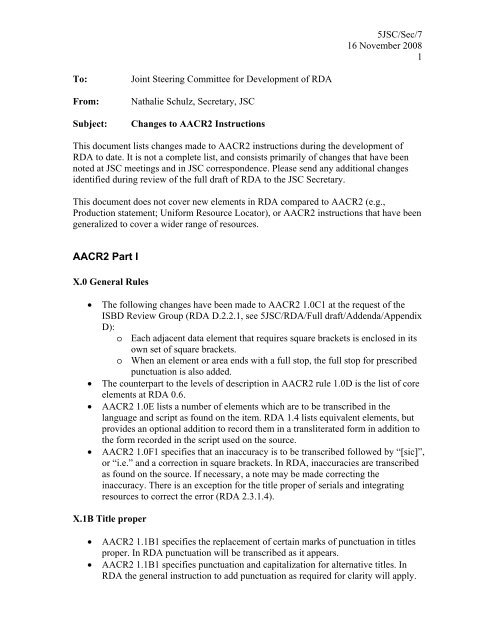

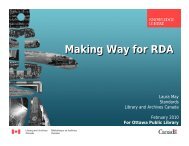
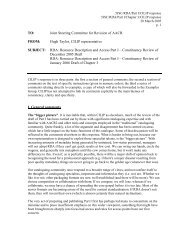
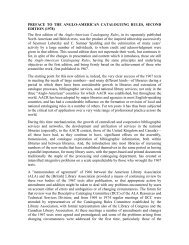
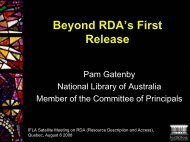



![Presentation slides [PDF] - Joint Steering Committee for ...](https://img.yumpu.com/41621230/1/190x143/presentation-slides-pdf-joint-steering-committee-for-.jpg?quality=85)

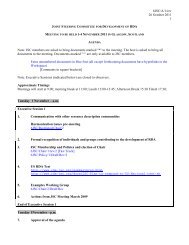
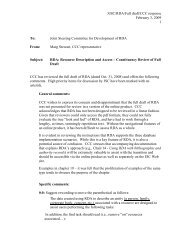
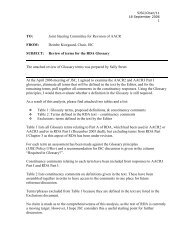
![Presentation slides [PDF] - Joint Steering Committee for ...](https://img.yumpu.com/35256207/1/190x143/presentation-slides-pdf-joint-steering-committee-for-.jpg?quality=85)
